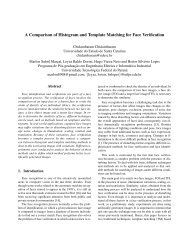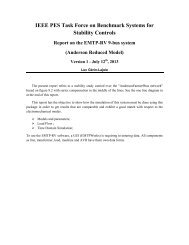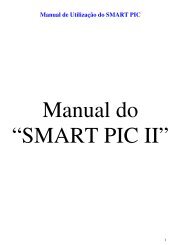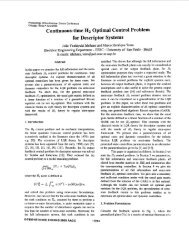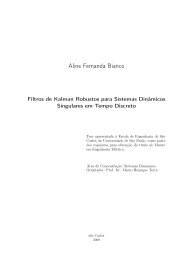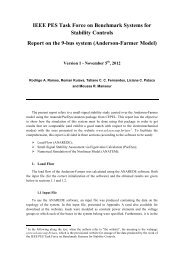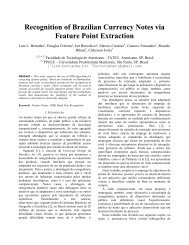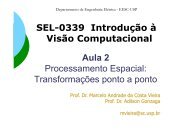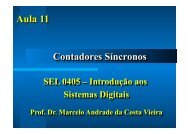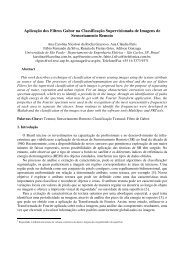<strong>WVC</strong>'<strong>2007</strong> - <strong>III</strong> Workshop de Visão Computacional, 22 a 24 de Outu<strong>br</strong>o de <strong>2007</strong>, São José do Rio Preto, SP.Quantidade de experimentosFaixa de taxade acerto Algoritmo ID3 Algoritmo MC480 – 84,9% 7 1285 – 89,9% 5 490 – 94,9% 5 395 – 99,9% 3 3100% 2 0Conforme se pode observar na tabela 2, o algoritmoID3 confirma o melhor desempenho, apresentando taxasde acerto maiores que 90% em quase 50% dosexperimentos; comparativamente, o algoritmo MC4alcançou taxas de acerto inferiores a 90% em 70% dosexperimentos.5. Conclusões e trabalhos futurosOs resultados experimentais demonstram que é viávelutilizar algoritmos indutores de árvores de decisão parainspecionar placas de circuito impresso montadas. Mesmocom considerável nível de ruído nas imagens-exemplo, o<strong>sc</strong>lassificadores obtiveram, no mínimo, 80% de acerto emédia geral de 86,7%; além disso, o melhor classificadorclassificou corretamente 100% dos exemplos do conjuntode execução.Cabe destacar que os melhores classificadores foramobtidos quando se utilizaram apenas característicasextraídas das imagens limiarizadas. Isso se deve,possivelmente, ao fato de as imagens monocromáticasapresentarem grande variância nos tons de cinza, o quetorna o seu histograma de tons de cinza uma característicade menor potencial di<strong>sc</strong>riminativo.A maior vantagem do método proposto, frente a outrastécnicas, consiste na utilização de características simplesda imagem, cuja extração é realizada com pequenoesforço computacional, e na possibilidade de se operarcom considerável nível de ruído.Futuramente, pretende-se estender o e<strong>sc</strong>opo destetrabalho a fim de que os algoritmos indutivos geremárvores de decisão capazes de classificar as imagens deplacas de acordo com o tipo de defeito encontrado.6. Referências[1] E. Moganti et al., “Automatic PCB inspection algorithms: asurvey”. Computer Vision and Image Understanding, Vol. 63,No. 2, 1996, pp. 287-313.[2] A. Hilton et al., “Automatic Inspection of Loaded PCB’sUsing 3D Range Data”. In: Proc. SPIE Machine VisionApplications in Industrial Inspection II, Vol. 2183, 1994, pp.226-237.[3] D. Unay and B. Gos<strong>sel</strong>in, “Apple Defect Detection andQuality Classification with MLP-Neural Networks”. In: Proc. ofPRORISC 2002, Veldhoven, Netherlands, November, 2002.[4] Z. Zhou and Y. Ziang, “Medical diagnosis with C4.5 rulepreceded by artificial neural network ensemble”. IEEETransactions on Information Technology in Biomedicine, 7(1),2003, pp. 37-42.[5] Instituto de Pesquisas Tecnológicas de Estado de São Paulo –IPT, “Sistema Computacional Embarcado de Inspeção VisualAutomática de Placas de Circuito Impresso: Anteprojeto eResultados Iniciais”. Relatório Técnico 93677-205, São Paulo,<strong>2007</strong>.[6] D. H. Ballard and C. M. Brown, Computer Vision. PrenticeHall, chapter 3, 1982.[7] J. Serra, “Image Analysis and Mathematical Morphology”.Academic Press, London, 1982.[8] A. M. Darwish and A. Jain, “A Rule Based Approach forVisual Pattern Inspection”. IEEE Transactions on PatternAnalysis and Machine Intelligence, vol 10(1), 1988, pp.56-68.[9] M.H. Tatibana and R. de A. Lotufo, “Novel automatic PCBinspection technique based on connectivity”. In: Proc. of XBrazilian Symposium on Computer Graphics and ImageProcessing (SIBGRAPI), 1997, pp. 187-194.[10] T. Cootes et al., “Statistical Grey-Level Models for ObjectLocation and Identification”. In: 6 th British Machine VisonConference, Birmingham: BMVA Press, England, Sept. 1995,pp. 533-542.[11] E. K. Teoh and D. P. Mital, “A Transputer-basedAutomated Visual Inspection System for Electronic Devices andPCBs”. Optics and Lasers in Engineering, vol. 22, 1995, pp.161-180.[12] S. Mashohor, J.R. Evans and T. Arslan, “Genetic AlgorithmBased Printed Circuit Board Inspection System”. In: IEEEInternational Symposium on Consumer Electronics, Reading,UK , September, 2004, pp. 519-522.[13] S. Mashohor, J.R. Evans and T. Arslan, “Elitist SelectionSchemes for Genetic Algorithm based Printed Circuit BoardInspection System”. In IEEE Congress on EvolutionaryComputation, Vol. 2, Sept. 2005, pp. 974-978.[14] M. Piccard et al., “Exploiting Symbolic Learning in VisualInspection”. Lecture Notes in Computer Science, vol.1280, 1997,pp.223-235.[15] M. C. Monard e J. A. Baranauskas, “Indução de Regras deÁrvores de Decisão”. In: Solange de Oliveira Rezende (ed.):Sistemas Inteligentes: Fundamentos e Aplicações, São Paulo:Editora Manole, 2003, pp.115-139.[16]Visual Prolog “Visual Prolog: Products, Compiler,Donwload Free Personal Edition”, Prolog Development CenterA/S, <strong>2007</strong>. Disponível em .Acesso em 23 de Julho de <strong>2007</strong>.[17] Delphi, CodeGear from Borland, <strong>2007</strong>. Disponível em. Acesso em 23de Julho de <strong>2007</strong>.[18] R. Kohavi, D. Sommerfield and J. Dougherty, “Data Miningusing MLC++ - A Machine Learning Li<strong>br</strong>ary in C++”, ToolsWith AI, 1996, pp. 234-245.[19] J. R. Quinlan, “Induction of decision trees”. MachineLearning, vol. 1, 1986, pp. 81-106.[20] J. R. Quinlan, C4.5: Programs For Machine Learning. SanFranci<strong>sc</strong>o: Morgan Kaufmann, 1993.203
<strong>WVC</strong>'<strong>2007</strong> - <strong>III</strong> Workshop de Visão Computacional, 22 a 24 de Outu<strong>br</strong>o de <strong>2007</strong>, São José do Rio Preto, SP.Usando MLP para filtrar imagensThiago Richter, Ediel Wiezel da Silva, e Adilson GonzagaDepartamento de Engenharia Elétrica, Universidade de São Paulo, Brasilthiago.richter@yahoo.com.<strong>br</strong>, edielws@gmail.com, adilson@<strong>sel</strong>.<strong>ee<strong>sc</strong></strong>.<strong>usp</strong>.<strong>br</strong>ResumoEste trabalho tem como objetivo estudararquiteturas e topologias de redes neuraisartificiais que possam ser usadas como filtros deimagens contendo ruídos. Serão realizados eapresentados testes usando diversas topologias,assim como a metodologia empregada seráapresentada.1. IntroduçãoO objetivo deste trabalho visa estudar arquiteturas etopologias de redes neurais artificiais que possam serusadas como filtros em imagens contendo ruídos, sendo aredução de ruídos necessária em casos como o desegmentação de imagens. Abaixo apresentam-se <strong>br</strong>eve<strong>sc</strong>onceitos relacionados a imagens ruidosas, de filtrosespaciais e redes neurais.1.1. Ruídos em imagensRuídos em imagens são padrões aleatórios de pontosque superpostos à imagem como resultado de qualquerinterferência, tanto na transmissão como na captura dainformação, degradando a imagem e dificultandoprocessamentos digitais de imagens, incluindo-seprincipalmente segmentação de imagens. Ruídos sempreestarão presentes em qualquer equipamento eletrônico, emmaior ou menor grau.A capacidade de simular o funcionamento e efeitos doruído numa imagem torna-se importante para estudarrestaurações de imagens, incluindo-se os filtros, visto queé possível comparar a imagem original com a imagemrestaurada através do uso da imagem com ruído[1]. Dentreos diversos tipos de ruídos aplicados a imagens, destacamseos ruídos Gaussiano, Poisson, Salt-and-Pepper eSpeckle.1.2. Filtros espaciaisFiltros espaciais são os filtros mais utilizadosatualmente em processamento de imagens digitais econsistem basicamente em definir um ponto central (x, y);executar operações envolvendo uma região de pixels(vizinhos) definidos a partir deste ponto central comvalores pré-definidos em um template (má<strong>sc</strong>ara), sendoesta vizinhança do mesmo tamanho que o template; umnovo valor do ponto central é atribuído através doresultado desta operação; e este processo é repetido paratodos os pontos da imagem [1]. Podem-se separar osfiltros espaciais em dois grupos, filtros espaciais lineares,se as operações realizadas no processo forem lineares efiltros espaciais não-lineares se estas operações não foremlineares.Dentre os filtros espaciais lineares, destacam-se osfiltros laplacianos e gaussianos e dentre os filtros nãolineares pode-se destacar o filtro da mediana. Filtrosderivativos como Sobel e Prewit são utilizadosprincipalmente para detectar bordas, assim como os filtrosde Canny e Laplaciano da Gaussiana (LoG).Dois exemplos de templates usados em filtros espaciaissão apresentados na figura (Fig. 1) abaixo:⎡ 0⎢(a)⎢−1⎢⎣0−14−10 ⎤⎥ ⎡1−1(b)⎥ ⎢0 ⎥⎣0⎦0 ⎤−1⎥ ⎦⎡ 0 1⎤⎢ ⎥⎣−10⎦Figura 1. Templates (a) Laplaciano, (b) Roberts.1.3. Redes Neurais ArtificiaisRedes Neurais Artificiais (RNA) são modelo<strong>sc</strong>omputacionais inspirados no cére<strong>br</strong>o humano e quepossuem a capacidade de aquisição e manutenção dainformação. As RNA podem também ser definidas comoum conjunto de unidades de processamento (neurônios)que são interligados por um grande número de sinapses[2]. Na Fig. 2 é apresentado o modelo geral do neurônioartificial de McCulloch, onde x são as entradas da RNA, wsão seus pesos, θ é o limiar de ativação, f é a função deativação e y a saída da rede.Tem como características a capacidade de adaptar ouaprender, inclusive aprender através de exemplos,capacidade de generalizar, agrupar ou organizar dados,auto-organizar, tolerar falhas e de não necessitar damodelagem matemática do processo. Suas principais áreasde aplicação são [2], [3]: reconhecimento de padrões,aproximação de funções, previsão/estimação, otimização204
- Page 1 and 2:
III Workshop de VisãoComputacional
- Page 3 and 4:
Instituto de Biociências, Letras e
- Page 5 and 6:
WVC 2007 - III Workshop de Visão C
- Page 7 and 8:
ApresentaçãoA área de Visão Com
- Page 10 and 11:
Automatic Pattern Recognition of Bi
- Page 12 and 13:
WVC'2007 - III Workshop de Visão C
- Page 14 and 15:
WVC'2007 - III Workshop de Visão C
- Page 16:
WVC'2007 - III Workshop de Visão C
- Page 19:
WVC'2007 - III Workshop de Visão C
- Page 22 and 23:
WVC'2007 - III Workshop de Visão C
- Page 24 and 25:
WVC'2007 - III Workshop de Visão C
- Page 26 and 27:
WVC'2007 - III Workshop de Visão C
- Page 28 and 29:
WVC'2007 - III Workshop de Visão C
- Page 30 and 31:
WVC'2007 - III Workshop de Visão C
- Page 33 and 34:
WVC'2007 - III Workshop de Visão C
- Page 35 and 36:
WVC'2007 - III Workshop de Visão C
- Page 37 and 38:
WVC'2007 - III Workshop de Visão C
- Page 39 and 40:
WVC'2007 - III Workshop de Visão C
- Page 41 and 42:
WVC'2007 - III Workshop de Visão C
- Page 43 and 44:
WVC'2007 - III Workshop de Visão C
- Page 45 and 46:
WVC'2007 - III Workshop de Visão C
- Page 47 and 48:
WVC'2007 - III Workshop de Visão C
- Page 49 and 50:
WVC'2007 - III Workshop de Visão C
- Page 51 and 52:
WVC'2007 - III Workshop de Visão C
- Page 53 and 54:
WVC'2007 - III Workshop de Visão C
- Page 55 and 56:
WVC'2007 - III Workshop de Visão C
- Page 57 and 58:
WVC'2007 - III Workshop de Visão C
- Page 59 and 60:
WVC'2007 - III Workshop de Visão C
- Page 61 and 62:
WVC'2007 - III Workshop de Visão C
- Page 63 and 64:
WVC'2007 - III Workshop de Visão C
- Page 65 and 66:
WVC'2007 - III Workshop de Visão C
- Page 67 and 68:
WVC'2007 - III Workshop de Visão C
- Page 69 and 70:
WVC'2007 - III Workshop de Visão C
- Page 71 and 72:
WVC'2007 - III Workshop de Visão C
- Page 73 and 74:
WVC'2007 - III Workshop de Visão C
- Page 75 and 76:
WVC'2007 - III Workshop de Visão C
- Page 77 and 78:
WVC'2007 - III Workshop de Visão C
- Page 79 and 80:
WVC'2007 - III Workshop de Visão C
- Page 81 and 82:
WVC'2007 - III Workshop de Visão C
- Page 83 and 84:
WVC'2007 - III Workshop de Visão C
- Page 85 and 86:
WVC'2007 - III Workshop de Visão C
- Page 87 and 88:
WVC'2007 - III Workshop de Visão C
- Page 89 and 90:
WVC'2007 - III Workshop de Visão C
- Page 91 and 92:
WVC'2007 - III Workshop de Visão C
- Page 93 and 94:
WVC'2007 - III Workshop de Visão C
- Page 95 and 96:
WVC'2007 - III Workshop de Visão C
- Page 97 and 98:
WVC'2007 - III Workshop de Visão C
- Page 99 and 100:
WVC'2007 - III Workshop de Visão C
- Page 101 and 102:
WVC'2007 - III Workshop de Visão C
- Page 103 and 104:
WVC'2007 - III Workshop de Visão C
- Page 105 and 106:
WVC'2007 - III Workshop de Visão C
- Page 107 and 108:
WVC'2007 - III Workshop de Visão C
- Page 109 and 110:
WVC'2007 - III Workshop de Visão C
- Page 111 and 112:
WVC'2007 - III Workshop de Visão C
- Page 113 and 114:
WVC'2007 - III Workshop de Visão C
- Page 115 and 116:
WVC'2007 - III Workshop de Visão C
- Page 117 and 118:
WVC'2007 - III Workshop de Visão C
- Page 119 and 120:
WVC'2007 - III Workshop de Visão C
- Page 121 and 122:
WVC'2007 - III Workshop de Visão C
- Page 123 and 124:
WVC'2007 - III Workshop de Visão C
- Page 125 and 126:
WVC'2007 - III Workshop de Visão C
- Page 127 and 128:
WVC'2007 - III Workshop de Visão C
- Page 129 and 130:
WVC'2007 - III Workshop de Visão C
- Page 131 and 132:
WVC'2007 - III Workshop de Visão C
- Page 133 and 134:
WVC'2007 - III Workshop de Visão C
- Page 135 and 136:
WVC'2007 - III Workshop de Visão C
- Page 137 and 138:
WVC'2007 - III Workshop de Visão C
- Page 139 and 140:
WVC'2007 - III Workshop de Visão C
- Page 141 and 142:
WVC'2007 - III Workshop de Visão C
- Page 143 and 144:
WVC'2007 - III Workshop de Visão C
- Page 145 and 146:
WVC'2007 - III Workshop de Visão C
- Page 147 and 148:
WVC'2007 - III Workshop de Visão C
- Page 149 and 150:
WVC'2007 - III Workshop de Visão C
- Page 151 and 152:
WVC'2007 - III Workshop de Visão C
- Page 153 and 154:
WVC'2007 - III Workshop de Visão C
- Page 155 and 156:
WVC'2007 - III Workshop de Visão C
- Page 157 and 158:
WVC'2007 - III Workshop de Visão C
- Page 159 and 160:
WVC'2007 - III Workshop de Visão C
- Page 161 and 162:
WVC'2007 - III Workshop de Visão C
- Page 163 and 164: WVC'2007 - III Workshop de Visão C
- Page 165 and 166: WVC'2007 - III Workshop de Visão C
- Page 167 and 168: WVC'2007 - III Workshop de Visão C
- Page 169 and 170: WVC'2007 - III Workshop de Visão C
- Page 171 and 172: WVC'2007 - III Workshop de Visão C
- Page 173 and 174: WVC'2007 - III Workshop de Visão C
- Page 175 and 176: WVC'2007 - III Workshop de Visão C
- Page 177 and 178: WVC'2007 - III Workshop de Visão C
- Page 179 and 180: WVC'2007 - III Workshop de Visão C
- Page 181 and 182: WVC'2007 - III Workshop de Visão C
- Page 183 and 184: WVC'2007 - III Workshop de Visão C
- Page 185 and 186: WVC'2007 - III Workshop de Visão C
- Page 187 and 188: WVC'2007 - III Workshop de Visão C
- Page 189 and 190: WVC'2007 - III Workshop de Visão C
- Page 191 and 192: WVC'2007 - III Workshop de Visão C
- Page 193 and 194: WVC'2007 - III Workshop de Visão C
- Page 195 and 196: WVC'2007 - III Workshop de Visão C
- Page 197 and 198: WVC'2007 - III Workshop de Visão C
- Page 199 and 200: WVC'2007 - III Workshop de Visão C
- Page 201 and 202: WVC'2007 - III Workshop de Visão C
- Page 203 and 204: WVC'2007 - III Workshop de Visão C
- Page 205 and 206: WVC'2007 - III Workshop de Visão C
- Page 207 and 208: WVC'2007 - III Workshop de Visão C
- Page 209 and 210: WVC'2007 - III Workshop de Visão C
- Page 211 and 212: WVC'2007 - III Workshop de Visão C
- Page 213: WVC'2007 - III Workshop de Visão C
- Page 217 and 218: WVC'2007 - III Workshop de Visão C
- Page 219 and 220: WVC'2007 - III Workshop de Visão C
- Page 221 and 222: WVC'2007 - III Workshop de Visão C
- Page 223 and 224: WVC'2007 - III Workshop de Visão C
- Page 225 and 226: WVC'2007 - III Workshop de Visão C
- Page 227 and 228: WVC'2007 - III Workshop de Visão C
- Page 229 and 230: WVC'2007 - III Workshop de Visão C
- Page 231 and 232: WVC'2007 - III Workshop de Visão C
- Page 233 and 234: WVC'2007 - III Workshop de Visão C
- Page 235 and 236: WVC'2007 - III Workshop de Visão C
- Page 237 and 238: WVC'2007 - III Workshop de Visão C
- Page 239 and 240: WVC'2007 - III Workshop de Visão C
- Page 241 and 242: WVC'2007 - III Workshop de Visão C
- Page 243 and 244: WVC'2007 - III Workshop de Visão C
- Page 245 and 246: WVC'2007 - III Workshop de Visão C
- Page 247 and 248: WVC'2007 - III Workshop de Visão C
- Page 249 and 250: WVC'2007 - III Workshop de Visão C
- Page 251 and 252: WVC'2007 - III Workshop de Visão C
- Page 253 and 254: WVC'2007 - III Workshop de Visão C
- Page 255 and 256: WVC'2007 - III Workshop de Visão C
- Page 257 and 258: WVC'2007 - III Workshop de Visão C
- Page 259 and 260: WVC'2007 - III Workshop de Visão C
- Page 261 and 262: WVC'2007 - III Workshop de Visão C
- Page 263 and 264: WVC'2007 - III Workshop de Visão C
- Page 265 and 266:
WVC'2007 - III Workshop de Visão C
- Page 267 and 268:
WVC'2007 - III Workshop de Visão C
- Page 269 and 270:
WVC'2007 - III Workshop de Visão C
- Page 271 and 272:
WVC'2007 - III Workshop de Visão C
- Page 273 and 274:
WVC'2007 - III Workshop de Visão C
- Page 275 and 276:
WVC'2007 - III Workshop de Visão C
- Page 277 and 278:
WVC'2007 - III Workshop de Visão C
- Page 279 and 280:
WVC'2007 - III Workshop de Visão C
- Page 281 and 282:
WVC'2007 - III Workshop de Visão C
- Page 283 and 284:
WVC'2007 - III Workshop de Visão C
- Page 285 and 286:
WVC'2007 - III Workshop de Visão C
- Page 287 and 288:
WVC'2007 - III Workshop de Visão C
- Page 289 and 290:
WVC'2007 - III Workshop de Visão C
- Page 291 and 292:
WVC'2007 - III Workshop de Visão C
- Page 293 and 294:
WVC'2007 - III Workshop de Visão C
- Page 295 and 296:
WVC'2007 - III Workshop de Visão C
- Page 297 and 298:
WVC'2007 - III Workshop de Visão C
- Page 299 and 300:
WVC'2007 - III Workshop de Visão C
- Page 301 and 302:
WVC'2007 - III Workshop de Visão C
- Page 303 and 304:
WVC'2007 - III Workshop de Visão C
- Page 305 and 306:
WVC'2007 - III Workshop de Visão C
- Page 307 and 308:
WVC'2007 - III Workshop de Visão C
- Page 309 and 310:
WVC'2007 - III Workshop de Visão C
- Page 311 and 312:
WVC'2007 - III Workshop de Visão C
- Page 313 and 314:
WVC'2007 - III Workshop de Visão C
- Page 315 and 316:
WVC'2007 - III Workshop de Visão C
- Page 317 and 318:
WVC'2007 - III Workshop de Visão C
- Page 319 and 320:
WVC'2007 - III Workshop de Visão C
- Page 321 and 322:
WVC'2007 - III Workshop de Visão C
- Page 323 and 324:
WVC'2007 - III Workshop de Visão C
- Page 325 and 326:
WVC'2007 - III Workshop de Visão C
- Page 327 and 328:
WVC'2007 - III Workshop de Visão C
- Page 329 and 330:
WVC'2007 - III Workshop de Visão C
- Page 331 and 332:
WVC'2007 - III Workshop de Visão C
- Page 333 and 334:
WVC'2007 - III Workshop de Visão C
- Page 335 and 336:
WVC'2007 - III Workshop de Visão C
- Page 337 and 338:
WVC'2007 - III Workshop de Visão C
- Page 339 and 340:
WVC'2007 - III Workshop de Visão C
- Page 341 and 342:
WVC'2007 - III Workshop de Visão C
- Page 343 and 344:
WVC'2007 - III Workshop de Visão C
- Page 345 and 346:
WVC'2007 - III Workshop de Visão C
- Page 347 and 348:
WVC'2007 - III Workshop de Visão C
- Page 349 and 350:
WVC'2007 - III Workshop de Visão C
- Page 351 and 352:
WVC'2007 - III Workshop de Visão C
- Page 353 and 354:
WVC'2007 - III Workshop de Visão C
- Page 355 and 356:
WVC'2007 - III Workshop de Visão C
- Page 357 and 358:
WVC'2007 - III Workshop de Visão C
- Page 359 and 360:
WVC'2007 - III Workshop de Visão C
- Page 361 and 362:
WVC'2007 - III Workshop de Visão C
- Page 363:
WVC'2007 - III Workshop de Visão C




